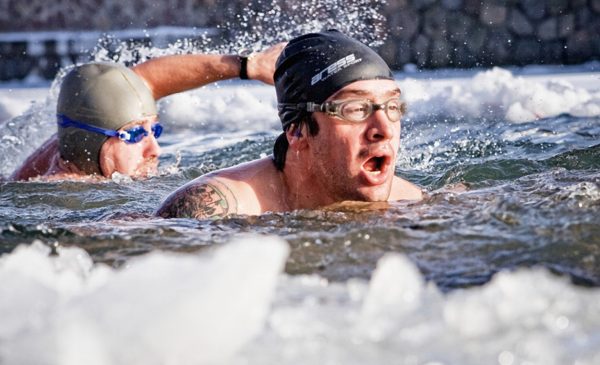Six things you should know about cold water swimming
Judging by the speed at which places for the 2013 Cold Water Championships have sold, cold water swimming is growing fast in popularity. That means people with little experience will be tempted to have a go. When you see acclimatised swimmers casually wading into cold lakes and swimming away it makes it look easy but there are plenty of risks. We’ve written on this subject at length in various issues of the magazine but with Christmas and New Year and the temptation for a celebratory dip just around the corner we thought it worth highlighting some of the dangers and safety tips.
1. What to wear
Traditionally, cold water swimmers use only a costume, goggles and a swimming hat. No wetsuits in sight. However, it’s not unusual to see people bending the rules slightly and putting on neoprene socks and gloves – the hands and feet are often what hurt most. Socks or boots also help protect numb toes and feet and from sharp stones. For your head, a thick silicone swim cap will keep your head warmer than a cheap, thin rubber one. Some people use two caps or put on a neoprene hat with ear flaps and a chin strap. Head-up breast-strokers may also put on a woolly hat, or even a fancy dress hat. If you’re swimming for pleasure (yes, really) then hats, gloves and socks are all down to personal preference, although some argue that you shouldn’t try to mask the early warning signals that you’re getting too cold. If you’re taking part in an event, check the rules, as gloves and socks probably won’t be allowed.
2. Cold water shock
Perhaps the biggest risk for the unwary, cold water shock is a reflex reaction to sudden immersion in cold water and is characterised by a sharp gasp, rapid rise in heart rate and the release of stress hormones. Breath holding can be seriously impaired. Cold water shock is reduced by familiarity, so repeated exposure to cold water, including cold showers, will help. Enter the water slowly and keep your head up until your breathing has stabilised, which normally takes a couple of minutes.
3. Loss of coordination
In the cold your body attempts to protect the vital organs of the core at the expense of your limbs. Your arms and legs will work less efficiently than in the warmth of your local heated pool. Therefore limit the time stay in the water, swim with other people and ensure you have an easy means of exiting the water.
4. Hypothermia
Extended exposure to the cold will eventually lower the core body temperature with ultimately fatal results. Onset is usually slow and can be difficult to spot. It is more of a risk for people attempting endurance or long-distance swims than taking a quick dip. Be alert to the symptoms and swim within your limits.
5. Ice
Never swim where there is any danger of becoming trapped under ice. Some people do swim where the surface ice can be broken and a safe channel cleared. As well as all the usual dangers of cold water be aware that ice can cut.
6. After drop
After you exit the water your core temperature can drop quickly as cooled blood from your extremities returns. Often swimmers don’t start shivering until sometime after they’re out of the water. Experienced swimmers will leave their clothes laid out and easy to put on immediately they exit the water. They will have flip-flops or similar at the water’s edge to protect their cold feet. Towel-off and dress at once. Put on a base layer followed by a thick jacket and a hat (pull this over your swimming cap if you like). Have a hot drink and get inside somewhere warm as quickly as possible but resist the temptation to plunge immediately into a hot bath. You should allow your body to rewarm gradually.
Despite the above warnings, if you’re in good health and sensible, cold water swimming (or at least the warm afterglow) can be an exhilarating and enjoyable experience.
Thanks to Colin Hill of Chill Swim for his input on these tips. If you fancy taking part in a supervised cold water event check out the Big Chill Swim.
Have fun over the break but stay safe.
(Picture: Jack Bright)







